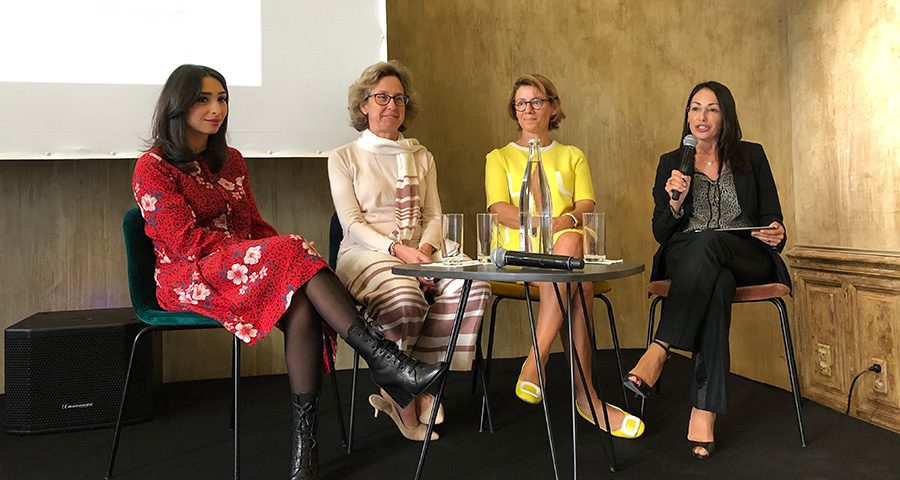Environmental, social and governance criteria are increasingly being scrutinised as sustainable investment soars. At BNP Paribas CIB’s Women in Business Club, an expert panel consisting of Ghizlaine Amrani, Co-Founder and Chief Operating Officer of QuantCube Technology, an AI-powered economic intelligence start-up; Myriam Durand, Global Head of Moody’s Investors Service Assessments; and Sheila ter Laag, Global Head of ESG Specialists at BNP Paribas Asset Management, discussed how to address the new challenges related to ESG data. The panel was moderated by BNP Paribas Group Chief Data Officer Rim Tehraoui. Here are some of the issues discussed.
How to ensure companies are really ESG-compliant?
The number of assets under management labelled as sustainable is increasing fast worldwide – up 34% between 2016 and 2018, according to figures from the Global Sustainable Investment Review 2018. To ensure that companies chosen for inclusion in a portfolio are really in line with specific ESG standards, analysis is vital. Sheila ter Laag said that BNP Paribas Asset Management employs specialised ESG analysts who look into risks and opportunities by sector. They use a combination of external data sources and proprietary methodology to form a view of a company not only from a quantitative perspective but also a qualitative and forward-looking one: two superficially similar companies might look quite different once their approach to the transition towards renewables is taken into account, for example.

What data to use and how?
Sheila ter Laag and Myriam Durand agreed that although quite a lot of ESG data is available, there are always questions about which data should be used, where to find it and how to interpret it, especially given the lack of international standards. Data providers may ascertain that certain companies have ESG policies – but that does not necessarily mean they adhere to these policies.
Ghizlaine Amrani talked about new forms of data that are becoming available thanks to big data, and which do not need to rely on company declarations. Her company aims to provide objective, quantitative data based on measurable performance indicators. One problem with some of the data currently used is that the way it is obtained is opaque, and that due to the absence of standards, the relative importance given to different kinds of data can differ by sector and by country.
One of the advantages of this “new” data is that it can be accessed and tracked in real time, rather than having to wait for reports or surveys, and can be used to see trends as they occur – and to look towards the future. One example is satellite imagery: a recent satellite, Sentinel-5P, monitors air pollution, and this data can be combined with weather data to see how the pollution spreads, what its impact is and where it comes from. Satellite data can also measure water levels in rivers, which affects not only agriculture but also other industries that use water transport.
The need for standards
The need for standards in ESG data was widely discussed. Various elements are in the pipeline, including the inclusion of the French law on energy transition in an EU regulatory package and upcoming recommendations from the Financial Stability Board’s Task Force on climate-related financial disclosures (the FSB’s TCFD). However, the panel agreed that the private sector cannot just wait for and rely on regulators, especially as they might not produce the kind of standards the market needs. Myriam Durand noted that Moody’s, as one of the rating agencies that set up standards for financial ratings, now has the ambition to create similar standards for non-financial risk – including ESG but also other risks such as cybersecurity.
ESG takes a financial turn
A participant in the meeting said that there is often a disconnect between corporate social responsibility and finance functions. Panellists agreed that it can be difficult to convince finance departments – and company boards – of the importance of CSR and said this is partly to do with the lack of clear data showing, for example, the financial cost of not participating in the ecological transition.
Myriam Durand said that boards need to prepare for situations where failure to take ESG criteria into account may result in impairment. Boards also need to do their duty and question top management about ESG-linked risk. Given the transition risk, physical risk and liability risks linked to these areas – not to mention the risk of uninsurability in certain climate scenarios – Sheila ter Laag noted that what once may have been considered as extrafinancial issues are now seen as having serious financial implications.
She and Ghizlaine Amrani also pointed out that millennials – the young people who companies are trying to attract as employees – are very interested in subjects such as gender parity (including on company boards, which tend to be particularly masculine) and equal salaries, and in the image of companies they might potentially work for or invest in. A company that does not take into account ESG criteria might find it difficult to attract top talent, which could endanger its financial performance.
BNP Paribas CIB’s Cécile Moitry, Head of the Sustainable Finance team, said the bank talks a lot to clients about how they integrate ESG criteria, and that bringing finance, treasury and CSR people together to discuss sustainable finance and how it can be linked to objectives and ambitions helps create stronger links between these parts of a client company.
Some companies are further ahead on the integration of ESG criteria: companies like BNP Paribas are striving to mainstream CSR and make it an integral part of company DNA.
The discussion was introduced by Alain Papiasse, CIB Chairman and chair and sponsor of the BNP Paribas CIB Women in Business Club. The Club was created in 2016, in the context of a partnership with the Women’s Forum launched in 2015.